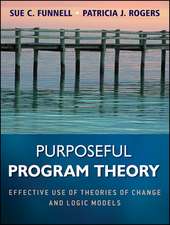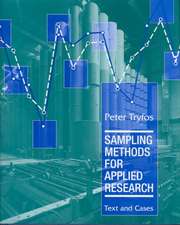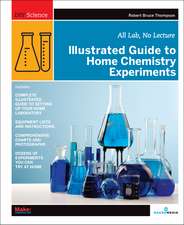Sense and Nonsense of Statistical Inference: Controversy: Misuse, and Subtlety: Popular Statistics
Autor Charmont Wangen Limba Engleză Paperback – 19 sep 2019
| Toate formatele și edițiile | Preț | Express |
|---|---|---|
| Paperback (1) | 489.26 lei 6-8 săpt. | |
| CRC Press – 19 sep 2019 | 489.26 lei 6-8 săpt. | |
| Hardback (1) | 618.42 lei 6-8 săpt. | |
| CRC Press – 16 dec 1992 | 618.42 lei 6-8 săpt. |
Preț: 489.26 lei
Preț vechi: 575.60 lei
-15% Nou
Puncte Express: 734
Preț estimativ în valută:
93.62€ • 98.01$ • 77.46£
93.62€ • 98.01$ • 77.46£
Carte tipărită la comandă
Livrare economică 05-19 aprilie
Preluare comenzi: 021 569.72.76
Specificații
ISBN-13: 9780367402563
ISBN-10: 0367402564
Pagini: 256
Dimensiuni: 156 x 234 x 18 mm
Greutate: 0.45 kg
Ediția:1
Editura: CRC Press
Colecția CRC Press
Seria Popular Statistics
ISBN-10: 0367402564
Pagini: 256
Dimensiuni: 156 x 234 x 18 mm
Greutate: 0.45 kg
Ediția:1
Editura: CRC Press
Colecția CRC Press
Seria Popular Statistics
Public țintă
ProfessionalCuprins
Part 1 Fads and fallacies in hypothesis testing: examples - the t-test; a two-stage test-of-significance; more examples - a Kolmogorov-Smirnov test; mechanical application of statistical tests; data snooping; an appreciation of non-significant results; type I and type II errors - for decision making; type I and type II errors - for general scientists. Part 2 Quasi-inferential statistics: randomness or chaos? Hume's problem; unobservables, semi-unobservables and grab sets; is statistics a science?; grab sets and quasi-inferential statistics; concluding remarks - quasi- and pseudo-inferential statistics. Part 3 Statistical causality and law-like relationships: sense and nonsense in causal inference - examples; Rubin's model and controlled experiments; Rubin's model and observational studies; causal inference in sample survey and other observational studies; causes, indicators and latent variables. Part 4 Amoeba regression and time-series models: discovering causal structure - science now can be easily cloned; regression and time-series analysis - science or lunacy? (part I); regression and time-series analysis - science or lunacy? (part II); regression and time-series analysis - science or lunacy? (part III); statistical correlation versus physical causation. Part 5 A critical eye and an appreciative mind toward subjective knowledge: the sorry state of statistical evaluation - a case study in educational research; modeling interaction effects - a case study from the social-behavioural sciences. Part 6 On objectivity, subjectivity and probability: statistical justification of scientific knowledge and scientific philosophy; classical probability, common sense and a strange view of nature; intuition and subjective knowledge in action - the Bayes theorem (and its misuse); Bayesian time-series analysis and E. T. (extra time-series) judgment; a pursuit of information beyond the data in randomized and nonrandomized studies; women and love - a case study in qualitative/quantitative analysis. Part 7 A delicate balance between order and chaos: reliability; order within chaos - heartbeats, brainwaves, simulated annealing and the fiddling of a system. Part 8 The riddle of the ubiquitous statistics: information and misinformation; statistical quality control and the conflicting teachings of Q.C. Gurus. Epilogue - toward a new perspective on statistical inference.
Recenzii
". . .Excellent guide for statistical users, educators, students. Shows that improper use of statistical inference can do more harm than good. "
---American Mathematical Monthly
". . .very informative. . . . . .should be read by all users of statistics. "
---Journal of Quality Technology
". . .illuminating, entertaining. . . . . .this book will be found most useful by graduate users of statistics who have been taught the techniques but have not subject them to critical scrutiny. . .professional statisticians will find fresh ideas about their subject here. "
---Australian Journal of Statistics
---American Mathematical Monthly
". . .very informative. . . . . .should be read by all users of statistics. "
---Journal of Quality Technology
". . .illuminating, entertaining. . . . . .this book will be found most useful by graduate users of statistics who have been taught the techniques but have not subject them to critical scrutiny. . .professional statisticians will find fresh ideas about their subject here. "
---Australian Journal of Statistics
Descriere
This volume focuses on the abuse of statistical inference in scientific and statistical literature, as well as in a variety of other sources, presenting examples of misused statistics to show that many scientists and statisticians are unaware of, or unwilling to challenge the chaotic state of statistical practices.;The book: provides examples of ub
















